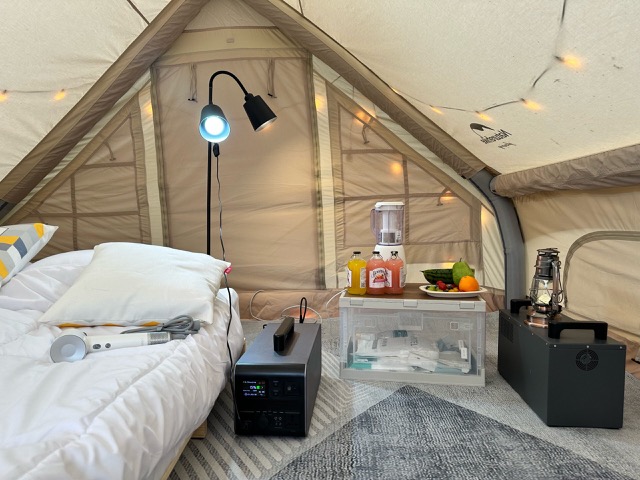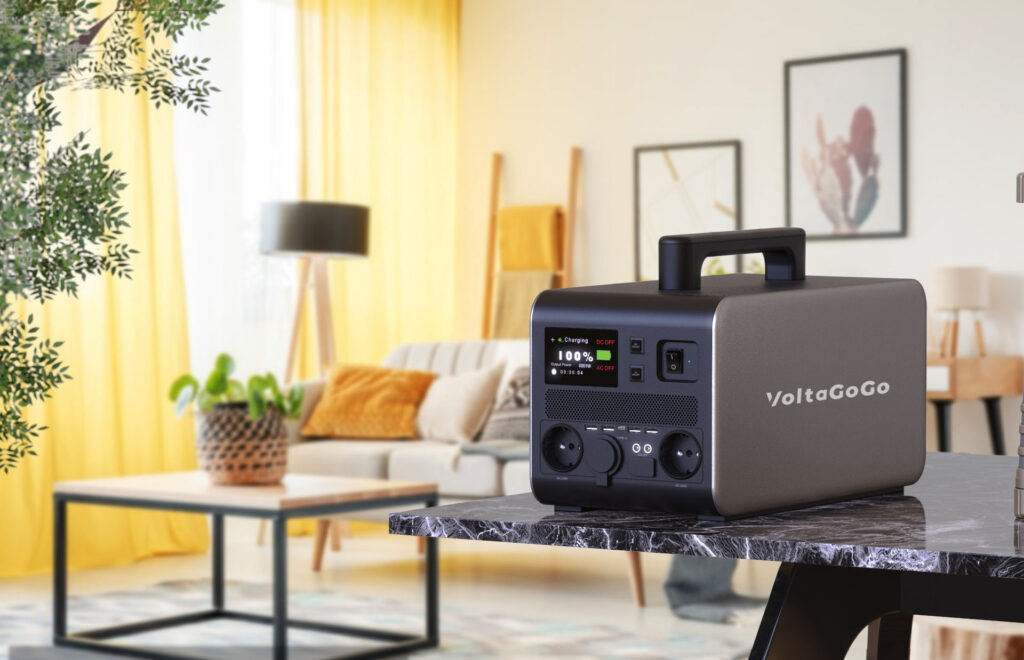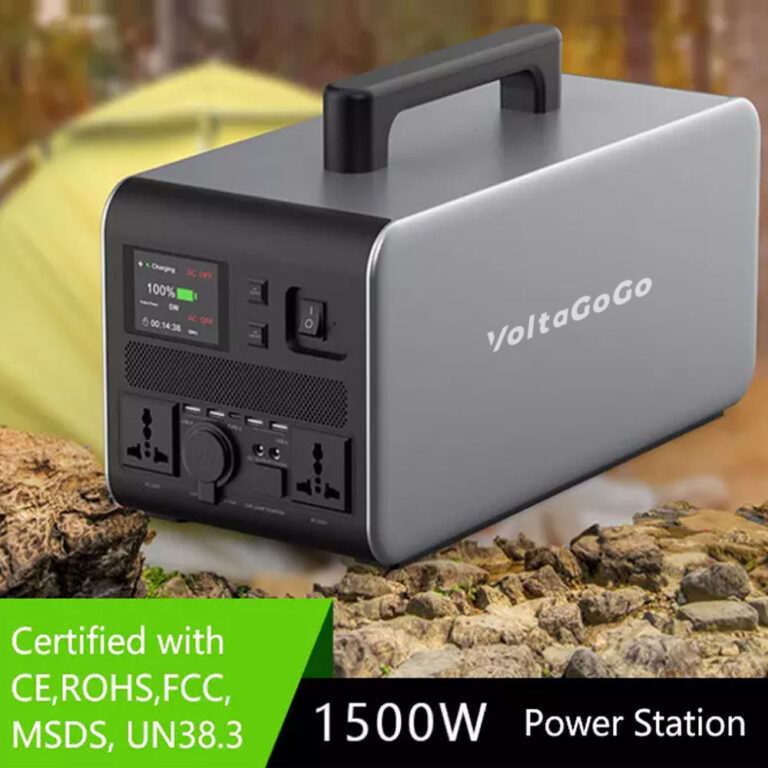
Are you curious about the range of appliances that can be powered by a portable power station? In this article, we’ll explore the versatility of portable power stations and discuss the various appliances they can effectively run. Whether you’re an outdoor enthusiast, a camper, or simply seeking a reliable backup power source, understanding the capabilities of a portable power station will help you make informed decisions. Let’s dive in!
A portable power station can power a wide range of appliances, providing you with convenience and peace of mind in various situations. Here’s a list of appliances that can be powered by a portable power station:
- Laptops and tablets
- Smartphones and mobile devices
- LED lights and camping lanterns
- Cameras and camera batteries
- Portable fans
- Small kitchen appliances (e.g., coffee makers, electric kettles, blenders)
- Mini refrigerators
- CPAP machines (for sleep apnea patients)
- Medical devices (e.g., nebulizers, blood pressure monitors)
- Electric wheelchairs and mobility scooters
- Power tools (e.g., drills, saws, sanders)
- Portable speakers
- Portable projectors
- Portable air compressors
- Portable TVs and monitors
- Electric blankets and heating pads
- Electric grills and griddles
- Electric coolers
- Electric pumps (for inflating air mattresses, pool floats, etc.)
- Radios and portable audio devices
- Portable printers
- Electric hairdryers and straighteners
- Electric toothbrush chargers
- Electric shavers
- Electric massagers
- Portable gaming consoles
- Electric insect zappers
- Electric blankets and heating pads
Now that we’ve explored the range of appliances that can be powered by a portable power station, let’s delve deeper into the factors you should consider when choosing a portable power station and how to calculate the runtime for specific appliances. Understanding these factors will help you select the right power station for your needs and ensure you have sufficient power to run your desired appliances.

Factors to Consider When Choosing a Portable Power Station
- Power Capacity: The power capacity of a portable power station is measured in watt-hours (Wh) or ampere-hours (Ah). Consider the total power requirements of the appliances you plan to use and choose a power station with sufficient capacity to meet your needs. Keep in mind that some appliances may have higher startup power requirements than their rated power.
- AC Outlets and USB Ports: Check the number and type of AC outlets and USB ports available on the power station. Ensure that it has enough outlets to connect the appliances you intend to use simultaneously. USB ports are useful for charging mobile devices and smaller electronics.
- Power Output: Look at the power output options provided by the power station. It should have suitable voltage and wattage outputs to support the appliances you want to run. Common outputs include AC (alternating current), DC (direct current), USB, and car cigarette lighter ports.
- Recharge Options: Consider the recharge options available for the power station. Some models can be recharged using AC wall outlets, while others may have solar panel compatibility or the ability to charge from a car’s 12V socket. Choose a power station with recharge options that align with your needs and available resources.
- Battery Type: Portable power stations typically use lithium-ion or lead-acid batteries. Lithium-ion batteries are lighter, have a higher energy density, and offer longer cycle life. Lead-acid batteries are heavier, less expensive, but have a shorter cycle life. Consider the battery type based on your portability needs and desired longevity.
- Weight and Portability: Evaluate the weight and portability of the power station, especially if you plan to carry it for outdoor activities or travel. Lighter models are easier to transport, while heavier ones may offer more capacity but can be cumbersome to carry.
- Safety Features: Check for safety features such as overcharge protection, short circuit protection, and temperature control. These features ensure the safe operation of the power station and protect your connected devices.
- Additional Features: Consider any additional features that may enhance the usability of the power station. This could include built-in LED lights, digital displays for battery status, integrated inverters for converting DC to AC power, or the ability to chain multiple power stations together for increased capacity.

How to Calculate Runtime for Specific Appliances
- Check the Power Rating: Start by checking the power rating of the appliance you want to run. This information is usually listed on the appliance itself or in the user manual. The power rating is typically measured in watts (W) and indicates the amount of power the appliance consumes during operation.
- Determine the Energy Consumption: Next, determine the energy consumption of the appliance over a specific period. This can be calculated by multiplying the power rating of the appliance by the time it will be used. For example, if you have a 100-watt appliance that will be used for 3 hours, the energy consumption would be 100 W x 3 hours = 300 watt-hours (Wh).
- Consider Efficiency and Losses: It’s important to account for efficiency and potential energy losses during the power conversion process. Portable power stations convert stored energy from the battery to usable power for appliances. Efficiency levels can vary, typically ranging from 85% to 95%. To calculate the required battery capacity, divide the energy consumption by the efficiency level. For example, if the energy consumption is 300 Wh and the efficiency is 90%, the required battery capacity would be 300 Wh / 0.9 = 333.33 Wh.
- Account for Battery Capacity: Compare the calculated battery capacity to the capacity of the portable power station. Ensure that the power station has enough capacity to provide the required energy. If the power station has a lower capacity, you may need to consider a larger or additional power station to meet your needs.
- Consider Multiple Appliances: If you plan to run multiple appliances simultaneously, calculate the energy consumption for each appliance separately and add them together. Make sure the total energy consumption does not exceed the capacity of the power station.
- Consider Battery Health: Over time, the battery capacity of a portable power station may degrade. If you’re using an older power station, it’s advisable to factor in the reduced capacity when calculating runtime. Check the manufacturer’s specifications or contact their customer support for information on battery degradation and its impact on runtime.
What to consider for Powering Multiple Appliances simultaneously
- Total Power Capacity: Explain that each portable power station has a specified total power capacity, typically measured in watt-hours (Wh) or kilowatt-hours (kWh). Discuss the importance of knowing the power capacity of your specific power station model before connecting multiple appliances.
- Calculating Combined Power Requirements: Guide readers on how to calculate the combined power requirements of the appliances they intend to use simultaneously. Encourage them to check the power ratings or wattage of each appliance and add them together to determine the total power needed.
- Managing Power Load: Emphasize the significance of managing the power load to avoid exceeding the power station’s capacity. Provide tips on prioritizing essential appliances and spreading the power usage evenly across different outlets or ports.
- Understanding Peak and Continuous Power: Differentiate between peak power and continuous power. Explain that certain appliances, such as refrigerators or air conditioners, may have higher peak power requirements during startup or certain operating modes. Ensure readers understand the importance of considering both peak and continuous power when connecting multiple appliances.
- Using Inverter and USB Ports: Highlight the versatility of portable power stations that offer both AC (inverter) outlets and USB ports. Discuss the power limitations and compatibility of different ports and advise readers on utilizing a mix of outlets and ports for different types of appliances.
- Using Power Strips or Extension Cords: Provide guidance on using power strips or extension cords to expand the number of available outlets. Remind readers to choose high-quality, surge-protected power strips that can handle the total power load.
- Monitoring Power Consumption: Encourage readers to monitor the power consumption of their connected appliances using built-in displays or external wattage meters. This helps them stay within the power station’s capacity and identify any power-hungry devices that may need adjustment or disconnection.
- Safety Precautions: Stress the importance of following safety guidelines and manufacturer instructions when using a portable power station to power multiple appliances. Remind readers to avoid overloading circuits, be cautious of heat buildup, and ensure proper ventilation to prevent any potential hazards.
- Consideration for Battery Drain: Explain that powering multiple appliances simultaneously will result in faster battery drain compared to running a single appliance. Discuss the importance of monitoring the power station’s battery level and planning for recharging or backup power options when needed.
- Optimizing Power Usage: Provide practical tips for optimizing power usage when running multiple appliances, such as using energy-efficient appliances, adjusting settings for lower power consumption, and minimizing idle power draw.

what Considerations for Outdoor Activities
- Portability and Weight: Discuss the significance of choosing a portable power station that is lightweight, compact, and easy to transport. Highlight the importance of considering the weight and dimensions of the power station, especially when planning for outdoor activities such as camping, hiking, or RV trips.
- Battery Capacity and Runtime: Explain the importance of battery capacity and runtime for outdoor activities. Discuss how the capacity of the power station’s battery will determine how long it can power your appliances while away from traditional power sources. Provide tips on estimating runtime based on the appliances you plan to use and the power station’s capacity.
- Charging Options: Discuss the various charging options available for portable power stations during outdoor activities. This may include solar charging, car charging, or using a generator. Explain the benefits and limitations of each charging method, and provide tips for selecting the most suitable option based on the specific outdoor setting.
- Durability and Weather Resistance: Highlight the importance of choosing a portable power station that is built to withstand outdoor conditions. Discuss features such as rugged construction, water resistance, and dustproof capabilities that make the power station suitable for outdoor use. Emphasize the need for durability, especially in unpredictable weather or rough terrains.
- Noise Level: Mention the significance of considering the noise level of the portable power station, particularly for outdoor activities that require a quiet environment, such as camping or wildlife observation. Discuss the benefits of selecting a power station with a silent or low-noise operation to avoid disrupting the outdoor experience.
- Safety Features: Discuss the safety features that are essential for outdoor activities. These may include overcharge protection, short-circuit protection, temperature control, and surge protection. Explain how these features provide peace of mind and ensure the safety of both the power station and connected appliances.
- Availability of Outdoor Accessories: Inform readers about the availability of outdoor accessories specifically designed for portable power stations. This may include solar panels, carrying cases, cable organizers, and mounting options. Discuss how these accessories can enhance the usability and convenience of the power station during outdoor activities.
- Environmental Considerations: Address the importance of environmental responsibility when using a portable power station in outdoor settings. Encourage readers to follow Leave No Trace principles, properly dispose of waste, and minimize their ecological footprint while enjoying the benefits of portable power.
- Compatibility with Outdoor Appliances: Provide insights into the compatibility of portable power stations with common outdoor appliances. Discuss the power requirements of devices such as camping lights, portable fans, electric grills, CPAP machines, and portable refrigerators. Guide readers on selecting a power station that can handle the power needs of their specific outdoor appliances.
- User Reviews and Recommendations: Encourage readers to seek user reviews and recommendations from outdoor enthusiasts who have experience with using portable power stations in similar outdoor activities. Mention the value of firsthand experiences and insights in making informed decisions.
Tips for Maximizing Battery Life
- Optimize Power Consumption: Encourage readers to be mindful of power consumption by using energy-efficient appliances and devices. Provide examples of energy-saving practices such as dimming lights, adjusting thermostat settings, or using power-saving modes on electronic devices.
- Prioritize Essential Appliances: Advise readers to prioritize essential appliances to conserve battery power. Suggest identifying the most critical devices and only powering those when battery life is limited. This ensures that vital functions, such as lighting or communication devices, are sustained for as long as possible.
- Unplug Unused Devices: Remind readers to unplug or disconnect any devices that are not actively in use. Even when turned off, some devices can still draw a small amount of power, contributing to unnecessary drain on the battery. Encourage them to develop the habit of unplugging unused chargers, appliances, and electronics.
- Manage Charging Cycles: Educate readers about the importance of properly managing the charging cycles of their portable power station. Explain that deep discharges and frequent shallow discharges can affect battery health over time. Advise them to follow the manufacturer’s instructions regarding charging and discharging cycles to optimize battery performance and longevity.
- Utilize Power-Saving Features: Highlight any power-saving features or modes available on the portable power station itself. These may include eco-mode, low-power standby, or intelligent power management systems. Explain how activating these features can help extend battery life by reducing unnecessary power consumption.
- Monitor Battery Level: Encourage readers to regularly monitor the battery level of their power station. This allows them to stay informed about the remaining power and make necessary adjustments to their usage. Recommend using built-in battery level indicators or external battery monitors for accurate readings.
- Utilize Solar Charging: If the portable power station supports solar charging, provide tips on utilizing this renewable energy source to extend battery life. Guide readers on positioning solar panels for optimal sunlight exposure, choosing the right solar panel wattage, and considering weather conditions for effective solar charging.
- Avoid Extreme Temperatures: Highlight the impact of extreme temperatures on battery performance. Advise readers to avoid exposing the power station to excessive heat or cold, as it can affect battery capacity and overall performance. Suggest storing the power station in a moderate temperature environment when not in use.
- Consider Additional Batteries: If applicable, suggest considering additional battery attachments or expansion packs to increase the overall capacity of the portable power station. This can provide extended runtime for longer trips or situations where power demands are high.
- Proper Storage and Maintenance: Provide guidelines on proper storage and maintenance practices to optimize battery life. This may include recommendations for cleaning the power station, ensuring proper ventilation, and storing it in a dry and secure location. Emphasize the importance of following the manufacturer’s instructions for long-term storage.
Portable power stations offer a versatile and reliable power source for running a wide range of appliances. By understanding the capabilities and considering important factors, you can confidently choose the right portable power station to meet your needs. Whether you’re exploring the great outdoors or preparing for unexpected power outages, a portable power station





